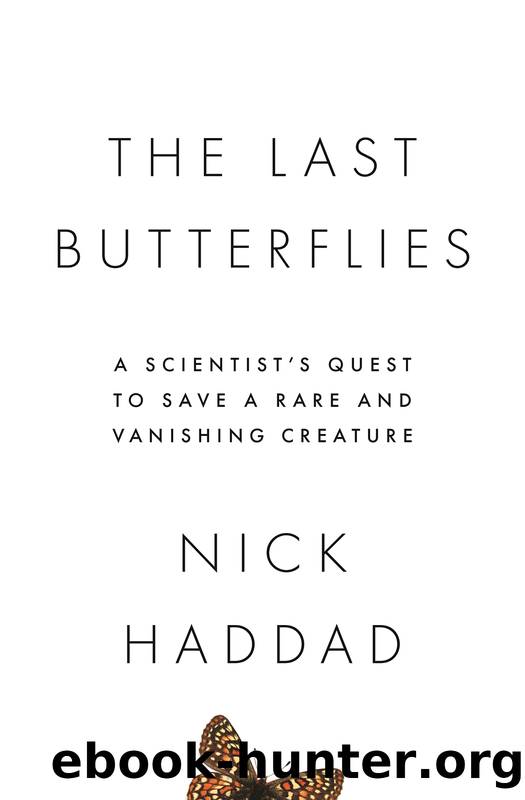The Last Butterflies by Haddad Nick;

Author:Haddad, Nick;
Language: eng
Format: epub
Publisher: Princeton University Press
Published: 2019-04-17T00:00:00+00:00
KILLING BUTTERFLIES TO SAVE BUTTERFLIES
After repeated visits to the artillery ranges, my concept of restoration for the St. Francisâ Satyr turned upside down. Intense and frequent disturbances caused by artillery fire were not, after all, harmful to butterflies. Large St. Francisâ Satyr populations in the ranges pointed to exactly the opposite conclusion. In addition to fire, ranges supported healthy populations of beavers, which flooded large stretches of streams. There was a giant difference between what I observed outside the artillery ranges and what I observed inside. The extensive metapopulations within formed an interconnected network of wetlands, such that individual butterflies from undisturbed wetlands could colonize disturbed areas where the vegetation was recovering. I could see now that disturbance was not harmful to the butterfly populations.
This experience forced me to admit that nearly every measure I had taken to conserve the St. Francisâ Satyr outside the artillery ranges had been wrong. My labâs conservation actions had protected the butterflies from direct harm, including via natural disturbances. My rationale had been that the St. Francisâ Satyr had existed in these areas for this long, and so, I assumed, it would continue to remain safe.
One of these wrong decisions occurred in my first year of research. A beaver dam grew downstream of a newly discovered St. Francisâ Satyr population. Biologists were worried that this dam would grow so big that it would flood out the population. The next year, the beavers were gone. The road engineers had used our concerns and the damâs flooding of a road as justification to remove the beavers. In the ensuing years, the butterfly population boomed. It expanded to colonize the area that had been underwater. A decade later, however, with no further disturbance, the population collapsed.
By doing nothing, I was, in fact, killing the butterflies. If protected from disturbance but otherwise let be, their open habitats continued through a natural course of succession, giving way to shrubs and then trees. These woodlands excluded the St. Francisâ Satyrâs host plant, and thus the St. Francisâ Satyr. Trees then introduced environmental feedback, acting like straws that sucked water from the soil. In doing so, they caused wetlands to dry. This reduced the habitatâs potential for the St. Francisâ Satyr even further. The irony was that by preventing fire or floods from killing the butterflies, we were killing them anyway. Herein lies a great paradox exposed vividly in the artillery ranges: we need to kill some butterflies to save butterfliesâindeed, to save a species.
Unlike my restoration targets outside the artillery ranges, the environments inside the ranges were turbulent. Fires and floods introduced constant change to the St. Francisâ Satyrâs habitats. The processes that seemingly destroyed habitat at the same time initiated a process that regenerated host plants and habitat the butterfly needed to thrive. What I observed firsthand was how artillery helped to recreate natural disturbances and habitat conditions that once defined this landscape before the armyâbefore peopleâever walked on it. It did so in at least two ways.
First, artillery-generated fires replaced natural fires.
Download
This site does not store any files on its server. We only index and link to content provided by other sites. Please contact the content providers to delete copyright contents if any and email us, we'll remove relevant links or contents immediately.
The Lonely City by Olivia Laing(4568)
Animal Frequency by Melissa Alvarez(4150)
All Creatures Great and Small by James Herriot(3986)
Walking by Henry David Thoreau(3681)
Exit West by Mohsin Hamid(3634)
Origin Story: A Big History of Everything by David Christian(3472)
COSMOS by Carl Sagan(3346)
How to Read Water: Clues and Patterns from Puddles to the Sea (Natural Navigation) by Tristan Gooley(3239)
Hedgerow by John Wright(3106)
How to Do Nothing by Jenny Odell(3101)
The Inner Life of Animals by Peter Wohlleben(3099)
How to Read Nature by Tristan Gooley(3077)
Project Animal Farm: An Accidental Journey into the Secret World of Farming and the Truth About Our Food by Sonia Faruqi(3018)
Origin Story by David Christian(2991)
Water by Ian Miller(2950)
A Forest Journey by John Perlin(2915)
The Plant Messiah by Carlos Magdalena(2745)
A Wilder Time by William E. Glassley(2690)
Forests: A Very Short Introduction by Jaboury Ghazoul(2671)
